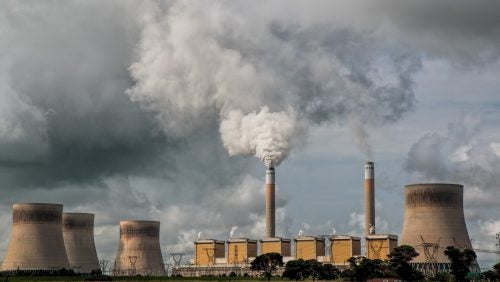Reclassification of Major Sources as Area Sources Under Section 112 of the Clean Air Act: A Farewell to “Once In, Always In”
November 9, 2020 by Hunter Johnston

Coal stacks emitting pollutants into the atmosphere
On October 1, 2020, the Environmental Protection Agency (EPA) finalized text for a final rule that proposed to change the way facilities that emit hazardous air pollutants (HAPs) are regulated under the Clean Air Act.[i] The rule, titled Reclassification of Major Sources as Area Sources Under Section 112 of the Clean Air Act, purports to implement a plain language interpretation of Section 112 of the Clean Air Act.[ii] In practical effect, the final rule provides that a “major source” can reclassify to “area source” status at any time after reducing its actual or potential hazardous air pollutants (HAP) emissions to below the major source threshold of 10 tons per year (tpy) of any single HAP and 25 tpy of any combination of HAPs.[iii] Additionally, the rule amends Clean Air Act requirements regarding compliance dates, notification, and record keeping.[iv]
What is a “Major Source”?
The Clean Air Act divides stationary sources of hazardous air pollutants into two categories: “major sources” and “area sources.” Major sources are defined as a stationary source or group of stationary sources that emit or have the potential to emit ten tons per year or more of a single HAP lutant or twenty-five tons per year or more of a combination of HAPs.[v] By contrast, “area sources” are defined as any stationary source that is not a “major source” (i.e. a stationary source that does not emit or does not have the potential to emit ten tons per year or more of an HAP or twenty-fivetons per year or more of a combination of HAPs).[vi]
Section 112 requires that the EPA establish emission standards for “major sources,” known as “maximum achievable control technology” or “MACT” standards, that require the maximum degree of reduction in emissions of HAPs.[vii] Accordingly, “major sources” are subjected to the highest degree of regulation.
Why is the EPA Enacting this Rule?
In May 1995, the EPA issued guidance establishing a “once in, always in” policy for major sources under the Clean Air Act.[viii] Under this policy, prior to its first MACT compliance date, a major source could reclassify and avoid MACT operation requirements if its potential to emit fell below major source threshold amounts.[ix] After the first compliance date, however, a major source could no longer reclassify and was permanently subject to MACT standards.[x] In other words, once a facility exceeded the major source threshold, it was locked into “major source” status and therefore subject to MACT requirements.
In January 2018, the EPA issued a guidance memorandum withdrawing the “once in, always in” policy.[xi] The EPA argued that the policy disincentivized facilities from deploying the latest pollution control technologies and presented an unnecessary regulatory burden.[xii] In response, a coalition of environmental groups and the State of California sued the EPA, challenging the aforementioned guidance memo.[xiii] In response, the EPA announced that it intended to formalize the policy withdrawal through notice and comment rulemaking.[xiv] The new rule represents the culmination of that rulemaking effort.
The EPA has justified the rule as reducing the regulatory burden and promoting fairness and flexibility.[xv] The EPA further justifies the rule as being consistent with the plain language of the Clean Air Act, relying on the statutory definitions of “major source” and “area source,” which neither contain language fixing a source’s status, nor preclude a source from changing its status.[xvi]
What Will the Rule’s Impact Be?
The EPA has touted cost savings and reduced regulatory burden as core justifications for the rule.[xvii] Indeed, the rule is likely to achieve those goals.
However, the true impact of the rule could be a significant increase in HAP emissions.[xviii] MACT standards, which are informed by the technology used by the best-controlled sources in the industry, significantly limit hazardous air pollutants.[xix] To replace MACT requirements with less stringent requirements would enable sources to increase emissions levels without meaningful modifications to their existing facilities.[xx]
After first applying the MACT, a source could either switch to weaker pollution controls, implement its controls less frequently, or operate at a lower efficiency.[xxi] Under this approach, the source could increase HAP emissions up to the major source threshold amount.[xxii] Accordingly, the rule enables some sources to increase emissions levels without incurring additional regulatory scrutiny.[xxiii]
[i] Documentation for Reclassification of Major Sources as Area Sources Under Section 112 of the Clean Air Act, Environmental Protection Agency (Oct. 1, 2020), https://www.epa.gov/stationary-sources-air-pollution/documentation-reclassification-major-sources-area-sources-under.
[ii] Reclassification of Major Sources as Area Sources Under Section 112 of the Clean Air Act, 40 C.F.R. § 63 (2020).
[iii] Id.
[iv] Id.
[v] 42 U.S.C. § 7412(a)(1).
[vi] 42 U.S.C. § 7412(a)(2).
[vii] Maximum Achievable Control Technology (MACT) Determinations for Constructed and Reconstructed Major Sources
, 40 C.F.R. § 63.43 (1996).
[viii] EELP Staff, Once In Always In Guidance for Major Sources under the Clean Air Act, Harvard Law School
Environmental & Energy Law Program, Feb. 2, 2018, https://eelp.law.harvard.edu/2018/02/once-in-always-in-guidance-for-major-sources-under-the-clean-air-act/.
[ix] Id.
[x] Id.
[xi] Id.
[xii] Supra note i.
[xiii] Supra, note viii.
[xiv] Id.
[xv] Supra, note 1.
[xvi] Nicole Bothwell, US EPA Formally Proposes Repeal of “Once In, Always In” Policy,Squire Patton Boggs: frESH L. Blog Jul. 16, 2019, https://www.freshlawblog.com/2019/07/16/us-epa-formally-proposes-repeal-of-once-in-always-in-policy/..
[xvii]EPA Office of Air Quality Planning and Standards, Regulatory Impact Analysis for the Final Reclassification of Major Sources as Area Sources under Section 112 of the Clean Air Act
9 (2020), https://www.epa.gov/sites/production/files/2020-10/documents/mm2a_final_ria_2020-09.pdf; supra, note 1.
[xviii] Supra, note viii.
[xix] Id.
[xx] See id.
[xxi] Id.
[xxii] Id.
[xxiii] See id.

